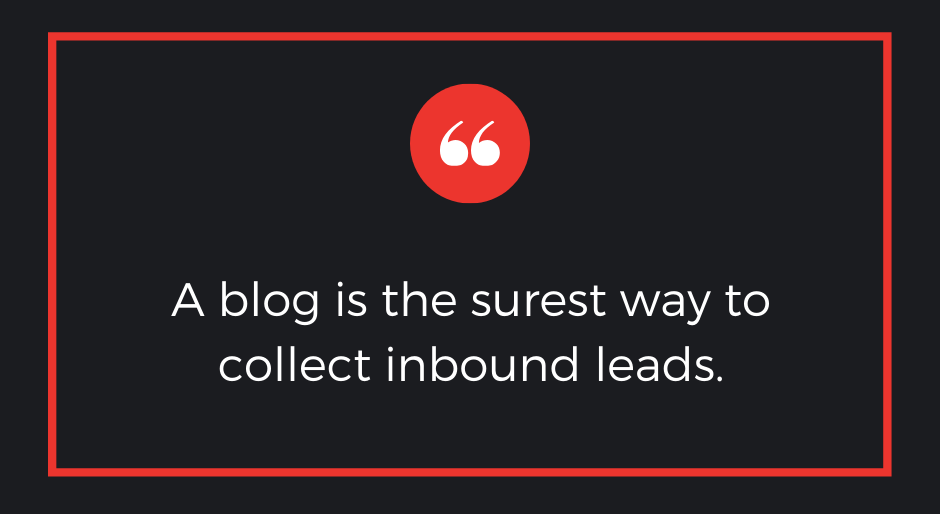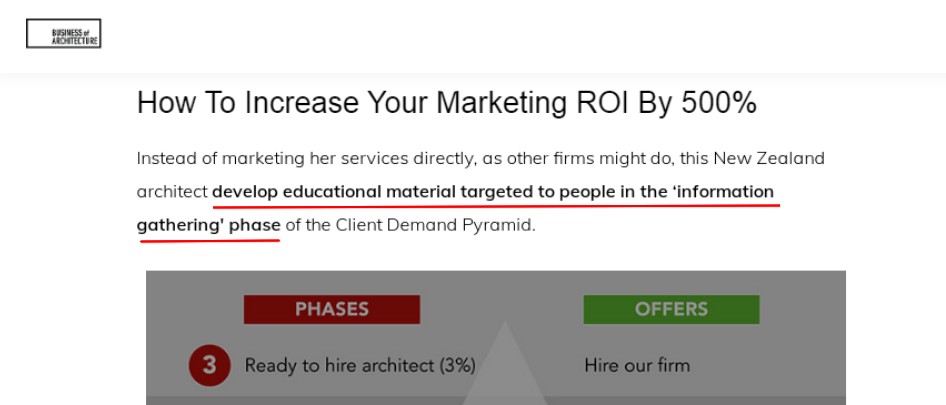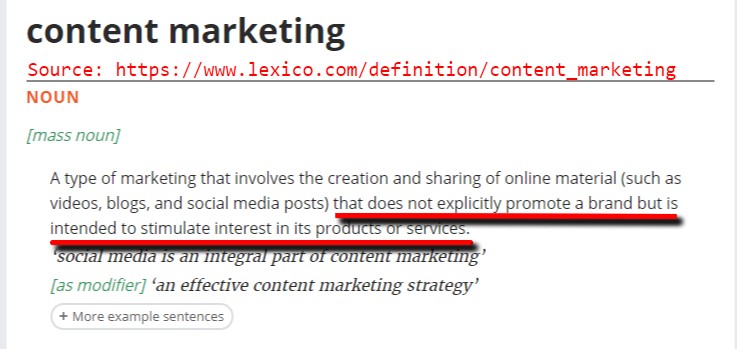Marketing as an architect or architectural firm is different from marketing any other business. Unlike traditional businesses, architects must have a continual inflow of work to remain profitable. To obtain that work, architects must market.
Shudder—the dreaded word.
Target market isn’t only about demographics
There are multiple steps to an architectural firm’s marketing plan. The first step is to define a market.
Defining a market must take into account:
- Demographics
- “Buyer persona“
- Lifecycle stage (Subscriber, Lead, Customer, etc.)
In short, who are you marketing to and where are they at in their lifecycle? By the end of this step, you will likely have defined more than one target market.
Each one of them requires a specific content strategy.
Content marketing strategy for different target markets
Different target markets will require different types of content explicitly angled to their interests and lifecycle stage.
No matter the frills surrounding or embedded into the textual content itself (images, infographics, videos, etc.), there will always be the text, the words and call-to-action phrases required to turn the lead or subscriber into a buyer.
The text is what a writer takes care of.
Screenshot: Marketing for Architects: 4 Winning Strategies
Here are six content marketing areas architects can use to market their brand.
1. Architectural Blog
Your blog is the frontline of content marketing. I visited several UK architectural business’s websites while researching this article and was not surprised to find that little-to-none had a blog or news section.
Those that did have a blog had either given up on it or were using it incorrectly. Abandoned or low-quality blogs are quite common.
A blog is the surest way to collect inbound leads.

And updating the blog with excellent quality articles which target specific keywords is the most cost-efficient, long-term online marketing strategy you could be doing.
In this respect, nothing beats long articles (3,000+ words) with high potential of making it to the top of Google’s search results, and of being shared across social media.
Long, informative articles also implement Enoch Bartlett Sears’s advice to “develop educational material targeted to people in the ‘information gathering’ phase”.
Marketing for Architects: The Authoritative Guide (with Case Studies)
A ghostwriter is invaluable in assisting with this. It takes a tremendous amount of skill to target articles to a market, to do keyword research, and to word and format articles in such a way that they both gather and keep interested readers.
It takes even more skill to write fresh and original content of over 3,000 words every week.
2. Social Media
Autodesk recommends using Social Media in an Architectural Firm’s marketing strategy. So do others.
Marketing for Architects: 7 Ways to Elevate Your Small Firm
Unlike your blog, which is aimed mainly at garnering inbound traffic, Social Media can hit several segments of your market.
A firm’s social media account can be followed by past or current clients, or by potential leads with whom your firm has never done business.
Having these two different target markets on the same channel doesn’t necessarily make coming up with content which appeals to both of them difficult.
The answer about what to write to interest both market segments is covered by the very definition of content marketing.
Content Marketing | Meaning of Content Marketing by Lexico
The entire purpose of content marketing is to produce content designed to stimulate interest without explicitly promoting the brand. Whether you’re leveraging social media to reach out to existing clients or new leads, the types of posts you’d be writing are the same.
They would be posts designed purely to attract interest, not to promote your brand as such.
It’s not merely a matter of plugging your social media account into an automated tool and letting it run. That will get you nowhere.
Whether social media or your blog, the need is the same: Smoking hot content that people find useful and want to tell others about.

Doing this successfully requires knowledge and experience in the subject of Content itself. But you’re an architect. You design structures for a living, not spend your daily hours understanding the intricacies and details of current social media trends.
A ghostwriter who writes social media content is invaluable here.
3. Email marketing
The Autodesk article referenced above also suggests getting an opt-in newsletter going.
You could have two newsletters going:
- A newsletter for existing clients who are more likely to be interested in your work or upcoming discounts.
- A general-interest architectural newsletter on any subject that people might find interesting.
That second newsletter would be for new leads.

Why would anyone who doesn’t know you subscribe to a newsletter about your brand?
They wouldn’t.
To get fresh leads, you have to give people something useful and interesting. You could do a weekly or monthly newsletter on impressive buildings around your area or the world.
Try angle the newsletter to your market. If your speciality is designing homes, create a newsletter for “Weekly ideas for remodelling your home” rather than “Interesting architectural designs around the world”.
The first example is more likely to garner you leads which become clients.
At the end of the newsletter, you could put a subtle mention of what you’re working on. You could even do the newsletter on past projects of yours — one a week.
The content ideas are limitless. A ghostwriter experienced in email marketing can help with this.
4. Offer an incentive ebook
One time-tested way to gain newsletter subscribers is to offer an ebook for download in exchange for somebody’s email address.
How to Give Away a Free Ebook (and Get More Subscribers)
Such ebooks are called incentive ebooks and are generally not very long. They are often laid out somewhat like a brochure of useful information. The incentive ebooks I’ve seen are usually downloadable PDFs.
But if your ebook is really a book, i.e. it has several hundred pages, then offering that book in various eReader formats is recommended.
The ideal incentive ebook is:
- Quick to read
- Visually appealing
- Helpful
It must also answer the very question the downloader was looking to get answered when signing up to download the book.

If the book doesn’t deliver, the prospect will simply unsubscribe.
The book should be concise and to the point.
For this step, an experienced ghostwriter who understands marketing and how to structure a book is imperative.
Because these books are so small, the cost of getting one written is quite affordable.
5. Public speaking
Both Archistar Academy and the Architect Marketing Institute recommend public speaking as a way to get new clients.
I did public speaking for years, both at school and then professionally. I’ve never had a problem in front of crowds.
But I was always prepared.

The trick to speaking in public with confidence and aplomb is to have a script that is well written and with which you are familiar.
It is quite a task to write a speech that hits all the right buttons and captivates your audience.
The rule is the same: Experience in writing content which resonates with people is key to producing engaging material.
An experienced ghostwriter who knows about public speaking and can write in both formal and informal register would be an excellent resource to have if you plan on getting into public speaking.
6. Do webinars
Another way to become better known and generate leads is to do webinars.
Whether you’ve been invited to sit in on a webinar by another company or are hosting one by yourself, you’ll need:
- A script/webinar notes
- A slideshow
There is some degree of graphical content that goes into the slideshow, but mostly the slideshow will consist of text.
Your ghostwriter could either provide you with a full script (which doesn’t work so well for webinars) or with bullet points and key phrases that you could use while going through the slideshow.
Why hire a ghostwriter?
Like all other firms that could benefit from ghostwriting, the most common reasons to hire one are:
- You have no time to write.
- You have some time to write, but not enough to research thoroughly enough and so make the article really stand out.
- You’re not much of a writer and would prefer someone else to put your jotted-down thoughts into coherent sentences and paragraphs.
- You might or might not have time to write, but have no time to stay up to date with the latest SEO changes and best practices.









